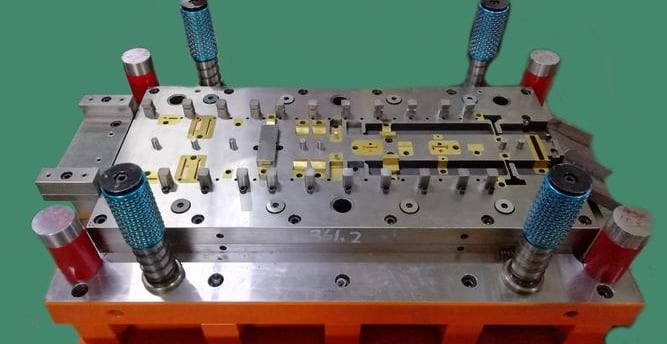The Relationship Between the Precision of Stamping Die and Production Capacity
3/4/2025


Understanding Stamping Die Precision
Stamping die precision refers to the accuracy with which a stamping die can create parts that meet specified dimensions and tolerances. In manufacturing, precision is crucial as it directly influences the quality of the final product, affects production efficiency, and minimizes waste. Different types of precision can be observed in stamping dies, notably dimensional accuracy, geometric tolerances, and surface finish quality. Each of these factors plays an essential role in determining the overall effectiveness of the stamping process.
Dimensional accuracy pertains to how closely the dimensions of the stamped components align with the required specifications. It helps manufacturers achieve uniformity across batches, ensuring that each piece meets the necessary criteria for functionality. Geometric tolerances, on the other hand, focus on the shape and arrangement of features within a component. This includes aspects such as flatness, roundness, and parallelism, which are vital for components that must fit together or operate in conjunction with other parts.
Surface finish quality refers to the texture and smoothness of the die's output. A superior surface finish can enhance the part's aesthetic appeal and functionality, impacting factors such as wear resistance and friction. In industries where precision components are paramount—such as automotive, aerospace, and electronics—the requirement for high-quality stamping dies becomes ever more significant. Precision in these contexts not only ensures compliance with stringent safety standards but also enhances product reliability, which is essential for customer satisfaction.
In conclusion, the precision of stamping dies has a considerable influence on the overall stamping process. By achieving high levels of precision in dimensional accuracy, geometric tolerances, and surface finish quality, manufacturers can enhance their production capabilities while maintaining quality and efficiency.
The Impact of Precision on Production Capacity
The precision of stamping dies plays a crucial role in determining production capacity in manufacturing environments. When die precision is high, it leads to more efficient production cycles. This efficiency manifests in several key areas, such as reductions in material wastage and defect rates, as well as decreased setup times during production shifts.
High-precision stamping dies ensure that parts are manufactured to exact specifications, allowing manufacturers to reduce scrap rates significantly. When dies produce parts that meet tight tolerances, the need for rework or waste due to defects diminishes, resulting in a more straightforward production process. This reduction in material wastage not only conserves resources but also contributes to cost savings, thereby enhancing the overall profitability of manufacturing operations.
Moreover, as precision improves, the frequency of defects in the stamped components decreases. Lower defect rates mean fewer interruptions in the production line, as operators spend less time inspecting and rectifying errors. This smooth operation ultimately increases the overall output per machine hour, contributing positively to the production capacity of the facility. Consequently, manufacturers that prioritize die precision often witness an extension in their operational capabilities and an increase in output.
Setup times, which can often severely hinder production capacity, are also positively impacted by precision. High-quality dies require less frequent adjustments and recalibrations, allowing manufacturing teams to transition between jobs with greater ease and efficiency. When a die is accurately constructed and maintained, the process of switching from one product line to another is hastened, thereby optimizing labor utilization and machine time.
In conclusion, the relationship between the precision of stamping dies and production capacity is significant. The advancements in die manufacturing techniques yield operations that are smoother, waste less material, and achieve higher output, establishing a notable connection that manufacturers must recognize to improve their processes.
Technological Advances in Stamping Die Production
The landscape of stamping die production has been transformed significantly by technological advancements in recent years. One of the most notable innovations is the implementation of computer numerical control (CNC) machining, which enhances the precision of stamping dies. CNC machines automate the die fabrication process, thereby reducing human error while ensuring consistent dimensions and quality. This automated consistency allows manufacturers to produce dies that meet stringent tolerances, which is crucial for high-volume production lines.
Moreover, the introduction of advanced materials for die manufacturing has played a pivotal role in the evolution of stamping dies. Traditional materials, while effective, often fail to provide the longevity and durability required for modern manufacturing demands. Newer materials, such as high-strength steel and advanced composites, offer greater resistance to wear and deformation, ensuring that the precision of stamping dies is maintained over extended production runs. The use of these advanced materials not only improves the lifespan of the tools but also contributes to the overall efficiency in production processes.
Additionally, simulation technologies have emerged as a game-changer in the design and refinement of stamping dies. These technologies allow designers to create virtual models of dies and simulate the stamping process, enabling them to identify and rectify potential issues before physical production begins. By employing finite element analysis (FEA) and other simulation methods, manufacturers can refine their designs to achieve optimal die performance. This proactive approach not only boosts the precision of the dies but also enhances overall production capacity, as less time is spent on troubleshooting and revisions during the manufacturing phase.
In this context, the integration of CNC machining, advanced materials, and simulation technologies illustrates that the precision of stamping dies is intricately linked to technological innovations. These advancements equip manufacturers to meet the ever-increasing market demands while maintaining superior quality in their production outputs.
Case Studies and Real-World Applications
In various industries, the significance of precision in stamping dies cannot be overstated, as it directly impacts production efficiency and capacity. A prime example can be found in the automotive sector, where manufacturers have shifted towards high-precision stamping processes to meet the increasing demand for more complex vehicle components. Companies like Ford and Toyota have integrated advanced stamping technologies which enable them to produce intricate parts that maintain tight tolerances. This innovation not only reduces waste but also enhances the overall quality of the final product, ultimately leading to a noteworthy increase in production capacity.
In the aerospace industry, precision stamping dies play a crucial role in the fabrication of lightweight components that require exceptional accuracy. Boeing has implemented high-precision stamping techniques that contribute to the construction of aircraft fuselage sections. By using stamping dies designed to yield components with negligible variances, Boeing has significantly decreased the time spent on post-manufacturing adjustments. This advancement has resulted in a faster production cycle, allowing for an increase in the overall output of aircraft, thereby aligning with the industry’s growing demand.
The electronics sector also demonstrates the benefits of precise stamping dies, particularly in the production of intricate electronic components such as connectors and circuit boards. Companies like Intel have adopted precision stamping technology to ensure high fidelity in their production processes. The integration of advanced dies has allowed for tighter part specifications, reducing the incidence of defects and enhancing overall manufacturing efficiency. This shift not only streamlines production but also leads to substantial cost savings, thereby justifying the initial investment in precision stamping technology.
These case studies highlight the transformative impact that precision stamping dies have on production capacity across diverse industries. By embracing this level of accuracy, companies can optimize their manufacturing processes, reduce waste, and ultimately improve their competitive positioning in the marketplace.
